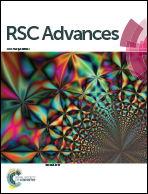Simultaneously toughening and strengthening cyanate ester resin with better dielectric properties by building nanostructures in its crosslinked network using polyimide-block-polysiloxane rod-coil block copolymers†
Abstract
Toughening without degrading rigidity, which is the major merit of a given heat-resistant thermosetting resin, has been a big challenge. Herein, two polyimide-block-polysiloxane (PI-b-PSi) rod-coil block copolymers with different concentration ratios of rod (polyimide, PI) to coil (polysiloxane, PSi) blocks were synthesized, and then new toughened cyanate ester (CE) resins with simultaneously improved strength and better dielectric properties were developed by building nanostructures in its crosslinked network using PI-b-PSi. The influence of the ratio of rod to coil blocks in the PI-b-PSi copolymer and the loading of PI-b-PSi on the structure and properties of the PI-b-PSi/CE resins are intensively discussed. Results show that the PI-b-PSi/CE system has a significantly lower curing temperature than CE, and the nanostructure in the crosslinked network of the PI-b-PSi/CE system is greatly related to the nature and loading of PI-b-PSi. For PI-b-PSi, of which the ratio of rod to coil blocks is 9 : 1 (coded as PI-b-PSi1), it forms well-dispersed spherical micelles in the crosslinked CE resin network, and the radius of the microdomains enlarges as the content of PI-b-PSi1 increases; when the ratio of rod to coil blocks is 7 : 3 (coded as PI-b-PSi2), wormlike and spherical micelles co-exist in the PI-b-PSi2/CE network. Compared with CE resin, all the PI-b-PSi/CE resins have reduced dielectric constants and loss, thus enhancing the most important feature of excellent dielectric property for CE resin; in addition, all the PI-b-PSi/CE resins have significantly improved toughness and rigidity. Typically, with a small addition of PI-b-PSi2 (5 wt%) into CE resin, its tensile strength and Young's modulus are increased by 52% and 16%, respectively; moreover, the impact strength and fracture toughness (KIC) are severally 2.4 and 3.9 times of that of CE resin. These outstanding performances demonstrate that PI-b-PSi has the super effect of toughening and strengthening CE resin on the basis of maintaining the major merit of CE resin, thus completely overcoming the bottleneck problem that exists in toughened resins reported previously. The origin behind this nature is intensively studied.


 Please wait while we load your content...
Please wait while we load your content...